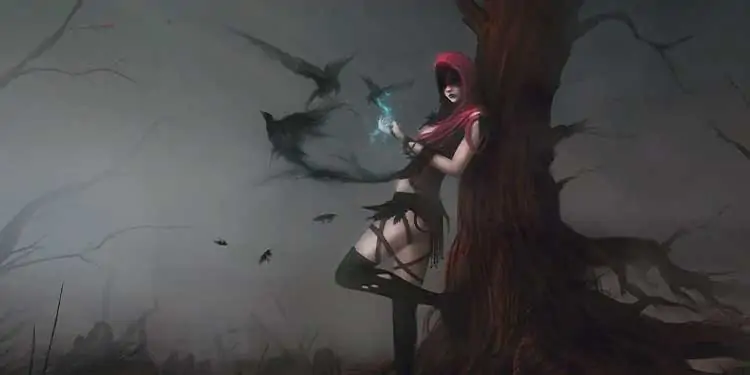Bioware’s Dragon Age is one of the most iconic RPG series. We’re looking at its three games, plus all of its campaign DLCs.
These games have original high fantasy medieval stories and debuted in 2009. Since then, the series has met massive commercial and cultural success. Fans and critics praise it for its narrative, RPG elements, lore, characters, and player choice.
Their games are available for Xbox 360, Xbox One, PlayStation 3, PlayStation 4, Windows, and Mac OS. However, the last entry debuted in 2015.
There’re 3 main Dragon Age games, 19 DLCs/expansions, 2 bundles, and four spin-offs. The total is 28 Dragon Age entries.
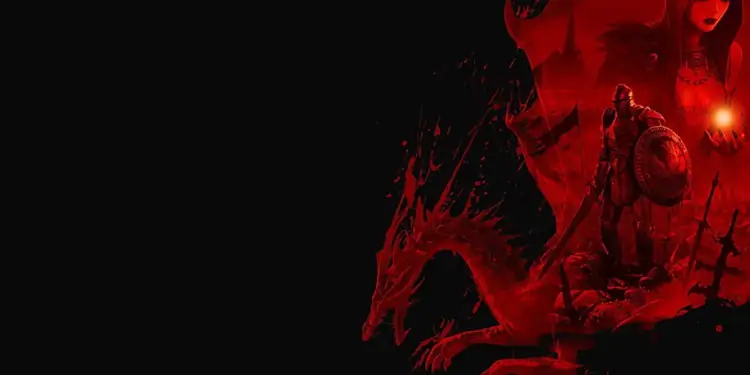
The Dragon Age Series
As a high fantasy tale, Dragon Age is a story of good vs. evil, heroes vs. villains. It’s also a story about the relationships characters create along the way and the general politics of the world colliding during times of crisis. Lastly, it’s a story of the rise of humankind while the rest of the races (like dwarves and elves) are slowly fading.
So, these are the Dragon Age elements present in all games:
Player choice: There’re multiple opportunities to choose from. You decide how to complete missions, when to complete tasks, and which sides to take at various parts in the story. These decisions may lead to branching paths and alternative endings.
Character creation: You can create your avatar by selecting genre, appearance, and class.
Character progression: Characters have a regular leveling system. Leveling up unlocks skill points you can invest into skills and skill trees. Additionally, the character can find increasingly better gear.
Relationships: You can talk to your companions and choose dialogue options. They can react to what you say, what you choose, and how you act. It may lead you to a friendship, loyalty missions, loyalty skills, romances, or rivalries.
Party members: Other characters join your party along the way. Every Dragon Age game allows 4 players per party. Even though the AI controls your companions, you can swap between the characters freely. However, the main character is often the most powerful.
Tactical view: Dragon Age doesn’t have turn-based combat. It’s a real-time action-RPG action akin to an MMO game. Nevertheless, you can activate the “Tactical View” mode. This birds-eye perspective pauses the game while you tell characters where to go and which powers to use.
Behaviors and strategy: Outside of combat, you can set the behavior of your companions during battle. For example, set when they should drink a potion, use a certain skill, or stun an enemy.
Combos: Lastly, the most essential idea in combat is combos. There’s elemental damage, physical damage, and other kinds of magical injuries. Different types of attacks may create powerful combos for varying effects.
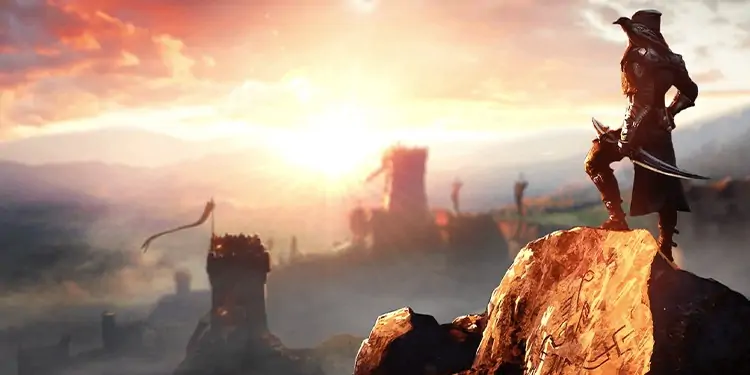
Every Dragon Age Games in Order
Dragon Age: Origins – 2009 (Main Game)
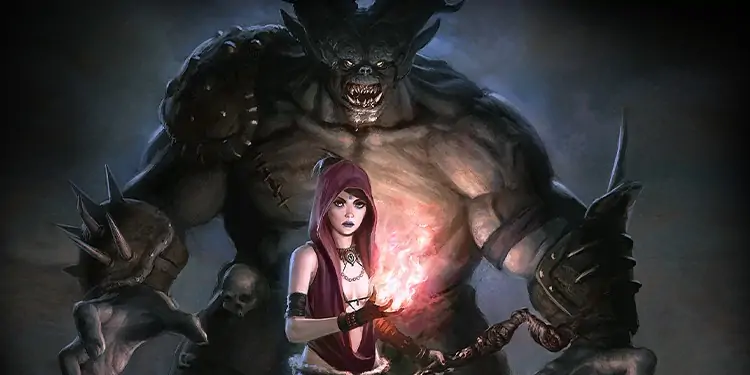
Origins debuted in 2009 for Windows, PlayStation 3, and Xbox 360. Currently, you may update its graphics and features through mods.
Bioware took inspiration from Dungeons & Dragons and Baldur’s Gate to create the DA series. Compared to its competitors, Dragon Age Origins leans more into the combat while still respecting the storytelling and characters. That said, there’re some similarities between the Dragon Age Universe and The Witcher’s lore.
The story happens across Thedas, but I’ll have to explain the lore before we go on:
According to the legends, the ancient Tevinter Empire sent its most powerful magicians into the heavens, the Golden City. Even though they succeeded, their greed corrupted the Maker’s realm and turned it into the Black City. The magicians became Archdemons, and the Archdemons vowed revenge against humans.
Meanwhile, dwarven raises dug nonstop beneath the Earth and created the Deep Roads to travel underneath. They were endlessly searching for treasures and magical artifacts. However, they discovered the Darkspawn. The Archdemons took their chance and raised the Darkspawn to invade the realm of the living.
The first game opens up during the fourth Darkspawn invasion, the fourth Blight. You play as a Grey Warden initiate, a nearly extinct group that goes through a ritual to gain the power of slaying an Archdemon.
Your goal is defeating the Archdemon to stop the Blight. You gain various companions, create alliances across Thedas, save various towns, and solve conflicts within the human kingdom. Ultimately go to war against the horde.
Across the story, you’ll find complex moral choices about murder, sacrifice, betrayal, genocide, and position. There’s no good or bad slider you can use as there’s no right answer. It depends on your role-playing.
More importantly, you pay a visit to the Veil, a feature present in all DA games. It’s often the best part of the games, as the Veil is loot, unique bosses, enemies, and otherworldly sights await.
Then, the third-person gameplay has a unique twist on the RPG genre. Depending on the race you choose, there’re six different origins in the game. This means the initial playthrough changes for noble humans, elves, dwarves, and others.
The initial playtime may be about 3 hours, and it marks the rest of your gameplay with different interactions and results. Also, each origin has a unique story detailing the lore of each race and city in the world.
Lastly, there’re three classes: warriors, archers, and mages. Each one features a basic skill tree, plus three advanced skill trees for unique character builds. Your companions also belong to one of these classes. However, combat doesn’t feel as satisfying as the rest of the story and the lore. It’s a bit janky, but we can forgive it because of its age.
Stone Prisoner – 2009 (DA:Origins DLC)
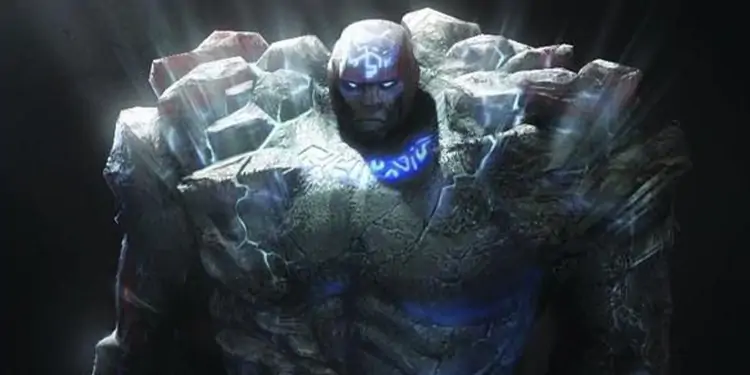
The first DLC debuted alongside the game. It adds Shale, a fully-voiced Golem that may join you as a companion. He has unique skills and mechanics.
Moreover, it added the location and the quest where you find Shale.
Warden’s Keep – 2009 (DA:Origins DLC)
It adds the Soldier’s Peak fortress as a base of operations for the player. Also, it explores the story behind the Grey Wardens’ exile from the Ferelden Kingdom.
The DLC debuted with the base game as well.
Dragon Age Journeys – 2009 (Spin-off)
Journeys was a free-to-play flash game set in the Dragon Age universe. It’s a 2D turn-based RPG with a single chapter.
Players go through a story in Orzammar, the Dwarven city, and the Deep Roads.
Return to Ostagar – 2010 (DA:Origins DLC)
It adds a new location to the game and the special loot you can find in Ostagar. Players can return to the ruined fortress where the human army first met the Blight, initially only present as part of a cinematic cut.
Feastday Gifts and Pranks – 2010 (DA:Origins DLC)
A minor DLC adds items to the game you can gift to the companions. Depending on the article, they may raise or lower your friends’ loyalty towards the Warden.
The Darkspawn Chronicles – 2010 (DA:Origins DLC)
It’s an alternative game mode that presents a “what-if” scenario. You play as a Darkspawn monster throughout a successful invasion of Ferelden.
Leliana’s Song – 2010 (DA:Origins DLC)
The next DLC is campaign content. It explores the backstory of one of your main companions, Leliana. She has her own companions and follows a heist-like mission.
The Golems of Amgarrak – 2010 (DA:Origins DLC)
Golems of Amgarrak is another campaign DLC. It takes the Warden-Commander to the Deep Roads to follow a missing dwarven expedition. They learn the journey was searching for a way to modify and create Golems.
Because you have new companions, the DLC features very challenging combat. Still, the content features strong rewards the player can carry over to the next expansion content. Lastly, the player may import their character or create a new Warden with base items.
Witch Hunt – 2010 (DA:Origins DLC)
Witch Hunt closes the story of another main companion, Morrigan. She disappeared after Origin’s end, and this is a closure for her story-arc.
As such, players can create a new Warden, or import their character to follow the story. The Warden’s companion is his Mabari war hound dog and two new characters. They are following Morrigan after she stole an ancient magical book.
Dragon Age Origins: Awakening – 2010 (DA: Origins Expansion)
Origins’ story wraps up with the Awakening expansion. It debuted in 2010 for Windows, PS3, and Xbox 360.
The new campaign raises the level cap and introduces new gear and skill mechanics. Also, both old and new companions are available.
It picks up six months after the main game’s conclusion. The Warden-Commander is rebuilding the guild at Vigil’s Keep. However, they must defeat remnants of the Darkspawn, and two new demons, to achieve their goal.
Dragon Age Origins: Ultimate Edition – 2010 (Bundle)
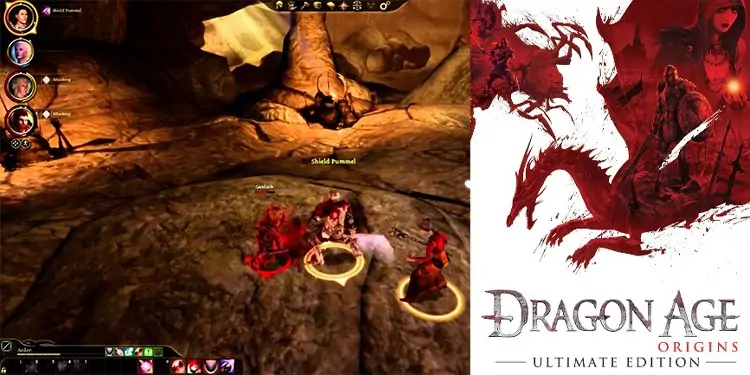
The Ultimate Edition bundles the base game, its DLCs, and the expansion.
Dragon Age II – 2011 (Main Game)
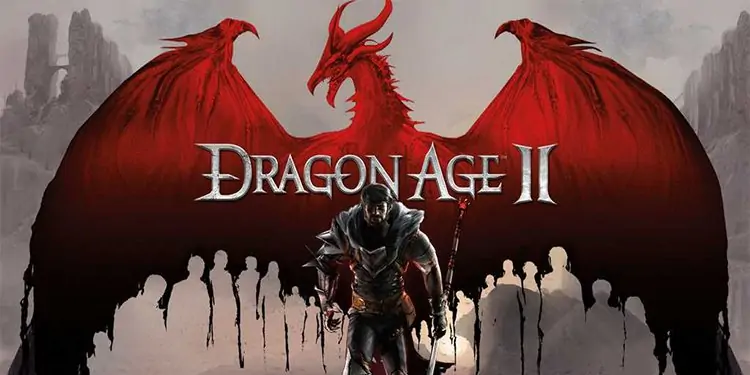
DA II debuted in 2011 for PlayStation 3, Xbox 360, and Mac OS. It’s a direct sequel for Origins, even though it presents entirely new characters and cities.
Given the short production cycle, DA II is not regarded as Origins. The game changed many things that worked on the first game in favor of an action-oriented experience. In fact, combat is akin to an a-RPG or a hack and slash title.
For instance, behavior tweaking and Tactical view became simpler. More importantly, you play as a base human character (Hawke) instead of an avatar. That means there’s no “origins” playtime and no race selection.
Similarly, the world became less fleshed out. Most of the game happens in Kirkwall, a free city, plus its outskirts. However, most of the areas, dungeons, and open sites are recycled maps of previous settings.
The story follows Hawke (the male or female sibling), who joined a group of survivors to flee the Blight. Players can choose the appearance and the class (mage, a rogue, or a warrior).
Once Hawke reaches Kirkwall, the story comes in three parts. During the first part, you join the most vivid character in the game, Varrick, on a greedy journey to the Deep Roads. Before going there, though, you go through a series of missions to earn money and pay for the expedition.
In Act 2, you deal with the Qunari. The Qunari is a culture of multiple races (mostly grey humanoids) joined by a single law and religion. Their people are stranded in Kirkwall, and you can help resolve the conflict in various ways.
Lastly, the third act further develops the Templar and the Mage orders. The Templars’ task is keeping the Mages in check, as magic can easily open portals to The Veil and summon demons. Anders, a character present in Awakening, uses the Deep Road artifact you found to “free” the mages from the Templars.
Although the game falls below the original RPG mechanics, its plot is still good and can expand the DA lore. Moreover, the combat became faster with more versatile skill trees. Lastly, the new companions are as interesting as always, and developing relationships is, again, the best part of the world.
Lastly, the game has a heavy emphasis on player choices. You’re to decide the expedition’s fate, the Templars, the mages, and the stranded Qunari. Aside from the main quest, you make choices on several side tasks as well.
The Exiled Prince – 2011 (DA II DLC)
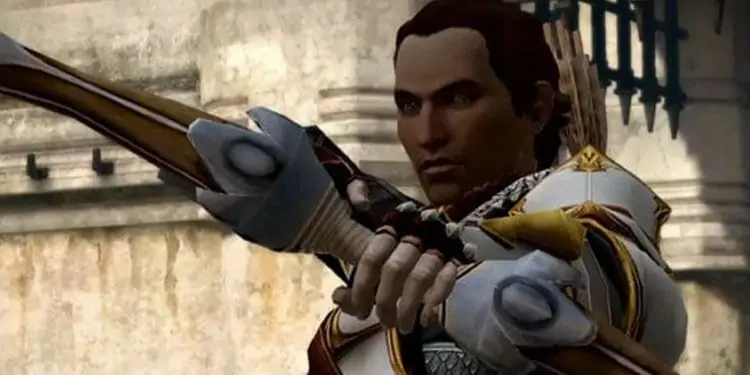
The first DLC introduces Sebastian Vael as a companion. He takes you to Orlais, a rivaling human kingdom, to seek vengeance for his family.
The Black Emporium – 2011 (DA II DLC)
The Black Emporium adds a special vendor to the game with special items. Across the offerings, you’d find the Mabari War Hound companion and the Mirror of Transformation to change facial appearance.
It was a free DLC and became available for every further DAII copy.
All-Class Item Packs – 2011 (DA II DLC)
Bioware released two editions of the All-Class Item Packs DLC. Each pack bundles about forty items for the three classes.
Legacy – 2011 (DA II DLC)
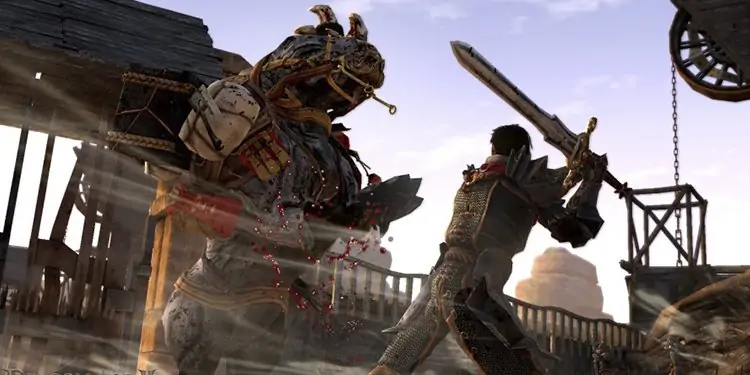
Legacy is the first story-driven DLC pack. It takes Hawke and his companions to a mysterious Grey Warden prison. There, Hawke discovers his lineage and the sins of Hawke’s father.
Moreover, the protagonist discovers an ancient evil locked in the Grey Wardens’ prison. It’s Corypheus, the main antagonist of the next main entry.
The DLC addressed fan concerns regarding wave-based enemies, repetitive locations, and lack of character customization. It packs a non-linear design, strategic enemies, a unique boss fight, puzzles, hidden areas, and an upgradable weapon.
Mark of the Assassin – 2011 (DA II DLC)
The final DLC ties with the web series (Dragon Age: Redemption). It’s another standalone story in the Chateau, a new Orlesian location.
It introduces Tallis, an elven who follows the Qunari system. She joins Hawke to infiltrate an Orlesian state and steal a relic. The setting introduces some light stealth mechanics.
Dragon Age Legends – 2011 (Spin-off)
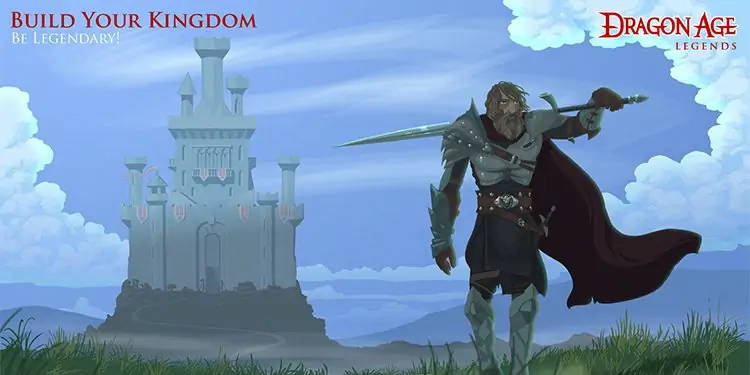
Legends was a 2011 freemium flash game by Electronic Arts. It debuted for Facebook and Google+.
Players could create their characters using the Dragon Age setting and play through a basic RPG. The game had a world map with “nodes” to visit and turn-based combat during battle scenarios.
The story ties Dragon Age: Origins and Dragon Age: II.
Heroes of Dragon Age – 2013 (Spin-off)
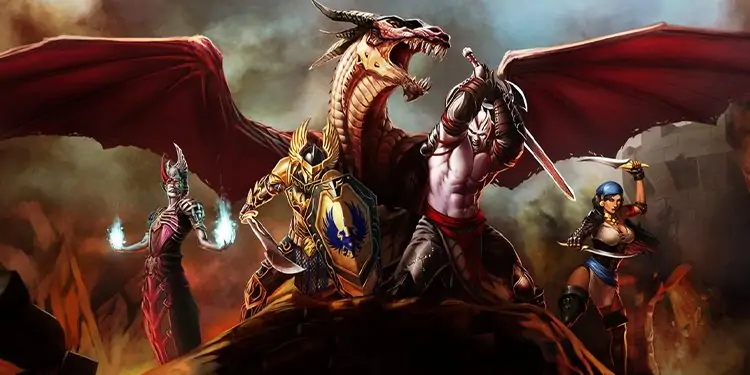
Heroes of Dragon Age is another freemium title. It debuted for Android and iOS devices in 2013.
The game offers a turn-based RPG with collectible character cards. It uses characters, lore, and plot points from the titular series.
You play with a squad of five characters throughout a squad-based strategy game. The battles play out automatically, and the result depends on your party, its abilities, formations, and runes.
Dragon Age: The Last Court – 2014 (Spin-off)
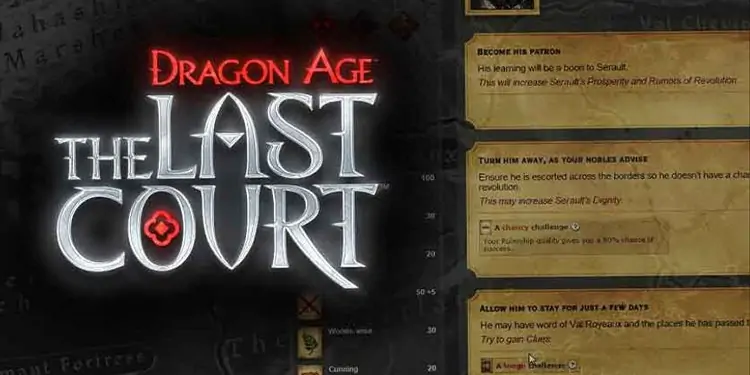
The Last Court is a free-to-play text-based game. It debuted for web browsers in 2014.
This experience ties the Dragon Age II and Dragon Age: Inquisition events. Players control the Marquis of Serault, a marquisate in Orlais. The Marquise guides Serault back to order after a tumultuous crisis.
The gameplay was about managing city resources by making decisions. The goal was accumulating wealth, Trophies, and Secrets to impress Divine Justinia V on her upcoming visit.
Dragon Age: Inquisition – 2014 (Main Game)
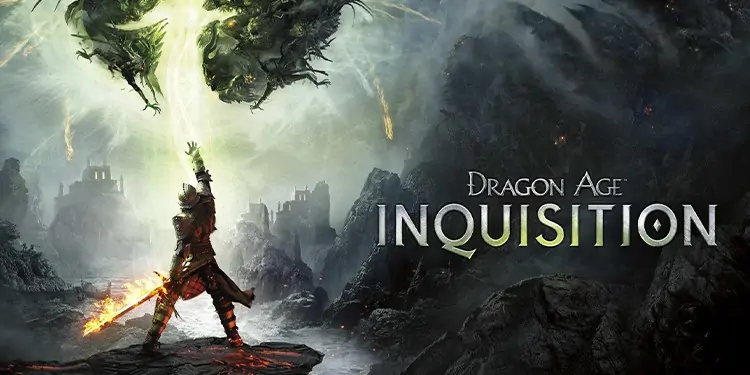
The latest entry debuted in 2015 for Xbox 360, Xbox One, PS3, PS4, and Windows. It picks up right after the events of the previous entry.
Archdemon Corypheus accidentally gave the protagonist a strange power when he returned to the world and killed Divine Justina V. The protagonist can close the Breaches, portals to The Veil dimension with the newly-found ability.
You can customize appearance, voice, gender, race, and sex to play the game. However, the story doesn’t change on either option. However, your special power opens up a unique skill tree with utility skills.
That said, the plot is about closing up the Breaches until eventually defeating Corypheus. Over time, people know the character as the Herald of Andraste. He also becomes the Inquisitor, leader of a newly-formed religious corps that seeks to restore order in the world.
Also, after the events of the last game, the Templars and Mages are in a war. The most important choice in the game relates to choosing either side as your ally against Corypheus. Similarly, you also deal with remnants of the Wardens.
The plot comes with a new open-world design. There’s a hub full of traders, NPCs, companions, upgrade stations, and a War Table. You can choose which maps to visit to complete a mission on the War Table. Also, you use it to send your soldiers and diplomats into special missions to gain loot, resources, and allies.
There’re several maps in the game, and each is vast and open. You need to complete the main mission on each one (closing a particular Breach), plus tons of optional side quests.
That said, the combat is fast-paced, flashy, and full of outstanding combos. Even so, it’s rather simple compared to previous entries. The skill trees are very simple, but the game retains complexity regarding player choices and companions.
On the same note, your companions have three basic threes, plus a single specialization three. It fits with the lore of the story, but it removes the player’s choice to develop companions in any way. Still, each class and skill tree is interesting and can create proper synergies and combos with other characters.
At the same time, the game added complex gear mechanics. There’re resources you can gather to create potions, gear, and upgrade gear. At the same time, there’s a vast amount of weapons, armor, and accessories.
Overall, it’s a vast ride full of exhilarating combat. Fans often complain about the first part of the game -the dreaded Hinterlands map. Nevertheless, it becomes much better after the initial portion.
Jaws of Hakkon – 2015 (DA: Inquisition DLC)
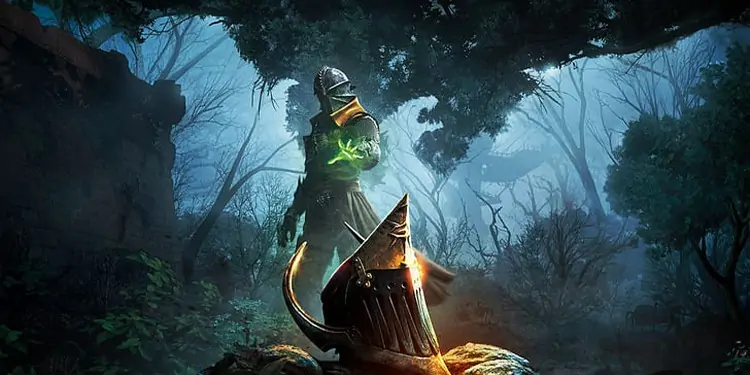
The first DLC takes the Inquisitor to a new map. They encounter the fierce Avvar tribe and help them defeat an ancient Tevinter evil.
Jaws of Hakkon introduces a new equipment tier, plenty of loot, and the most challenging boss battles thus far.
Spoils of the Avvar – 2015 (DA: Inquisition DLC)
It adds new customizable items, various mounts, and unique armor.
Spoils of the Qunari – 2015 (DA: Inquisition DLC)
The following content also adds items to the game, like items to customize your hub (Skyhold), an armor set, and schematics.
The Descent – 2015 (DA: Inquisition DLC)
The Descent is a campaign DLC that takes the Inquisitor exploring the Deep Roads. It’s a massive quest that uncovers a secret deep within the Earth.
Trespasser – 2015 (DA: Inquisition DLC)
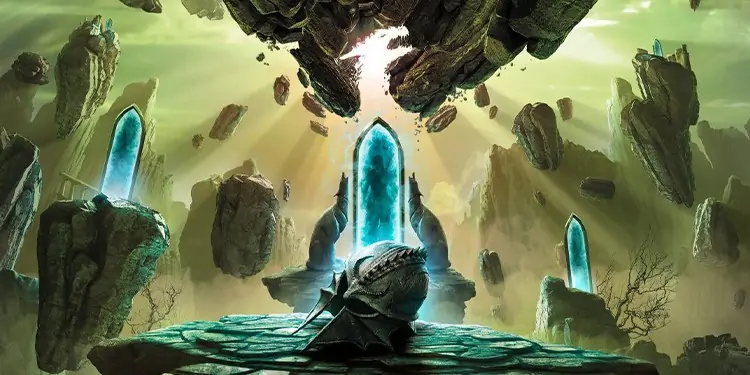
After defeating Corypheus, the Inquisitor’s next mission leads him to a new evil. You uncover a plot by the Dreadwolf, an ancient elven God.
The Dreadwolf is one of your companions, the one who gave you the Rift powers as part of his schemes. He’s looking to reclaim the former glory of his people, the Elves.
Dragon Age: Inquisition – Game of the Year Edition – 2015 (Bundle)
The GotY edition packs the base game plus all of the available DLCs.
Every Dragon Age Game in Chronological Order
- Dragon Age: Origins – 2009
- Stone Prisoner – 2009
- Warden’s Keep- 2009
- Dragon Age Journeys – 2009
- Return to Ostagar – 2010
- Feastday Gifts and Pranks – 2010
- The Darkspawn Chronicles – 2010
- Leliana’s Song – 2010
- The Golems of Amgarrak – 2010
- Witch Hunt – 2010
- Dragon Age Origins: Awakening – 2010
- Dragon Age Origins: Ultimate Edition – 2010
- Dragon Age II – 2011
- The Exiled Prince – 2011
- The Black Emporium – 2011
- All-Class Item Packs – 2011
- Legacy – 2011
- Mark of the Assassin – 2011
- Dragon Age Legends – 2011
- Heroes of Dragon Age – 2013
- Dragon Age: The Last Court – 2014
- Dragon Age: Inquisition – 2014
- Jaws of Hakkon – 2015
- Spoils of the Avvar – 2015
- Spoils of the Qunari – 2015
- The Descent – 2015
- Trespasser – 2015
- Dragon Age: Inquisition – Game of the Year Edition – 2015
FAQ
Will the Dragon Age Series Continue?
Yes. Dragon Age 4 is currently under pre-production. The plot will revolve around the White Wolf. However, there has not been any news since the 2020 trailer during the Game Awards.

